Breather is a nonlinear wave with localized oscillation of energy. Similar to solitons, breathers in dissipative systems can form stable bound states, exhibit molecular-like dynamic behavior, and are often referred to as breather molecules. So far, experimental observations of optical respirator molecules and real-time detection of their dynamics have been limited to diatomic molecules (bound states of two respirators). Here, researcher Peng Junsong of East China Normal University and others observed three types of breather molecule complexes in ultrafast fiber lasers, including multiple breather molecules, a complex composed of two breather pairs (2+2), and a breather pair. and a breather molecular complex composed of a single breather (2+1). The intermolecular spacing of this breather molecular complex reaches hundreds of picoseconds, which is more than an order of magnitude higher than that of the corresponding soliton molecular complex, indicating that it is a long-range interaction. Recent theoretical studies have shown that breathers that are far apart can exchange energy through the dispersion wave of the tail and are bound together through harmonic synchronization. This is the intrinsic mechanism of long-range interaction of breather molecules. In addition, the researchers also studied the non-equilibrium dynamics of breather molecular complexes, including the inelastic collision and annihilation behavior of breathers. Finally, numerical simulations of the laser model described by the Ginzburg-Landau equation confirmed the experimental phenomenon. This work opens up the possibility of multi-body dynamics research using breathers as the basic structure. The work was published in Laser Photonics Rev.
The concept of solitons is general and can be applied to a large class of solitary wave propagation phenomena observed in most branches of nonlinear science, from fluid dynamics and biology to plasma physics and photonics. The main characteristics of solitons are long propagation time and no obvious changes. In initial theoretical studies, solitons were considered to be integrable Hamiltonian systems, such as the one-dimensional nonlinear Schrödinger equation, but more recently, the original concept has been extended to nonlinear dissipative systems, where localized wave packets arise from dispersion or diffraction and nonlinearities (e.g., solitons) and the trade-off between gains and losses. In addition to their formation, their interactions such as collisions and even the emergence of stable bound states are currently subjects of intensive study in laser physics through real-time ultrafast measurements. This dissipative multi-soliton complex, also known as a soliton molecule, is the result of the self-organization phenomenon within the laser cavity and exhibits dynamic behaviors similar to material molecules, such as synthesis and vibration. By transferring the general spectroscopic concepts to the case of dissipative solitons, the resonance excitation and all-optical switching of soliton molecules under external perturbation is achieved, thus extending the analogy of material-like soliton molecules. Soliton pairs consisting of two bound solitons are currently the most studied multi-soliton structures, and a recent study showed that two soliton pairs can combine to form stable molecular complexes.
In addition to traditional solitons, many nonlinear systems support breathing dissipative solitons with periodic oscillatory behavior. Dissipative breathers were first demonstrated in passive Kerr cavities and subsequently reported in optical microresonators. The average dynamics of the dissipative system is governed by the complex Ginzburg-Landau equations, which also support breather solutions. Passively mode-locked lasers are a suitable platform to study the properties and dynamics of nonlinear dissipative systems, in which case the existence of an operating region in which laser oscillators generate strong breathing solitons has recently been theoretically predicted. Researchers directly reveal the fast spectral and temporal dynamics of breathers in mode-locked fiber lasers through real-time detection techniques. Similar to the Akhmediev and Kuznetsov-Ma breather s in traditional nonlinear systems, the breathing dissipation solitons are related to the Fermi–Pasta–Ulam resonance, an anomaly in which a nonlinear coupled oscillator periodically returns to its original state. evolution. Breathing solitons are not only an important research object in nonlinear science, but also receive widespread attention due to their potential applications in fields such as spectroscopy.
In contrast to the significant progress in the study of soliton molecular dynamics in ultrafast lasers, the existence of breather bound states has been less studied. In the traditional system described by the nonlinear Schrödinger equation, the modes of breathers have been studied the most, and only breather collisions and periodic breather interactions have been reported. In fact, in such systems, overlapping soliton pulses cannot form strong bonds because the effective interaction potential of the pulses is not a minimum. The potential energy minimum can only be caused by dissipation effects, resulting in the formation of multi-pulse bound states. There have been many new studies on the observation of breathing soliton pairs in mode-locked fiber lasers. It is worth mentioning that in mode-locked lasers, in addition to the formation of breathing molecules, various significant dissipative local structural dynamics have also been experimentally studied, including soliton explosions, breathing explosions, and the generation of optical strange waves.
Generation of breather molecular complexes
The experimental device for producing breather molecular complexes is an erbium-doped passive mode-locked fiber laser with normal path average cavity dispersion, as shown in Figure 1. Mode locking relies on nonlinear polarization evolution technology, which is achieved by including two fiber polarization controllers and a polarization-dependent isolator. The nonlinear transfer function is adjusted by a simple rotation loop, thereby changing the linear cavity loss and achieving pulse-to-pulse interaction. The researchers conducted real-time analysis of the laser output signal in the time domain and frequency domain. Subnanometer resolution spectral measurements are obtained at the lens-to-lens level using the dispersive Fourier transform method. This simple yet powerful method, now a commonly used tool for obtaining spectral dynamics on ultrashort time scales, maps the spectrum of the laser output to a time waveform read directly on a real-time oscilloscope. This is accomplished by stretching the laser output pulse in a dispersive medium that accumulates a sufficiently large group velocity dispersion to satisfy far-field conditions such that the stretched waveform represents the spectral intensity of the original pulse waveform. By measuring the time trajectories of the one-dimensional intensity in real time and then using these trajectories to construct the time domain intensity evolution of the laser, the latter reveals the dynamics of fast time and slow evolving propagation coordinates, which are measured as several cavity roundtrips.
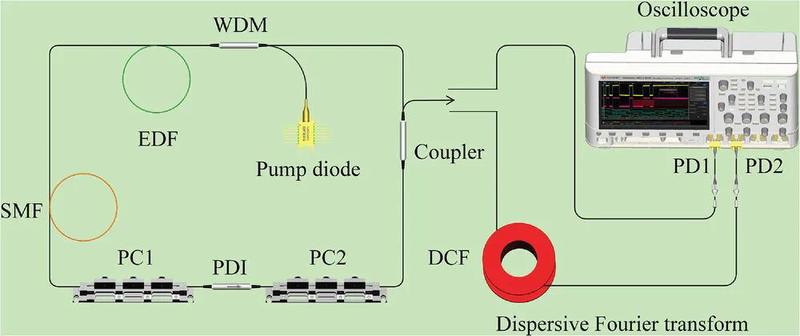
Figure 1 Schematic diagram of laser and real-time detection system. WDM, wavelength division multiplexer; PC, polarization controller; PDI, polarization dependent isolator; SMF, single-mode fiber; EDF, erbium-doped fiber; DCF, dispersion compensation fiber.
When the pump current is set to 44.9 mA, the laser operates in a stable single-pulse mode-locked state, which is characterized by soliton-like pulse shaping. When the pump current is increased to 46 mA, self-initiating mode locking is accompanied by the generation of multiple pulses per cavity round trip. The stable single-pulse regime exists within a narrow pump power range because the cavity length is longer than the typical length of most mode-locked fiber lasers (<10 m). In the experiment, the pump current was fixed at 46 mA, and the cavity loss was adjusted by slight rotation of the polarization controller to produce various breathing complexes. In addition, the laser can maintain two, three, and four bound soliton states. Figure 2 shows the dynamics of a breather quadruplet ("four-atom molecule"). The spatiotemporal intensity evolution depicted in Figure 2a reveals large periodic changes in the intensity of the four fundamental breather s with a period of 1000 round-trips. The peak intensity varied by nearly an order of magnitude within each pulsation cycle (Fig. 2b). At the same time, the pulse duration also changes and the time resolution of the detection system (approximately 30 ps) does not allow to capture this change. However, this technique may be difficult to implement when the pulse undergoes large breathing. Despite periodic intensity changes, the pulse time interval remains almost constant at 50 ps over successive cavity round-trips, indicating strong binding between pulses.
The rapidly evolving behavior of the pulse temporal intensity leads to rapid changes in the spectrum, which are beyond the speed of traditional spectral measurement tools (e.g., optical spectrum analyzers). To this end, the researchers used real-time dispersive Fourier transform spectroscopy monitoring to capture the spectral evolution of pulsed quartets as they travel to and from the cavity. Single-point spectral measurement based on dispersion Fourier transform, as shown in Figure 2c. The spectrum has the typical interference pattern present in soliton molecular spectra, with the intervals between spectral intensity peaks matching in time the pulse intervals. The evolution of the spectrum during a cavity round trip is cyclic and the spectrum broadens and narrows substantially during each cycle, with broadening (compression) occurring naturally near where the pulse reaches its highest (lowest) peak intensity. The maximum width of the spectrum exceeds the minimum width by more than eight times (Fig. 2d). The energy of the pulsed quartet (white curve in Figure 2c) is calculated by integrating the power spectral density across the entire band and evolves synchronously with the spectral width and pulse temporal intensity during the round trip. To complete a quantitative dynamic image of the breather quadruple molecules, the researchers used dispersion Fourier transform-based spectral interferometry to resolve the relative phases within the molecules in real time, which relies on calculating the Fourier transform of each single dispersion Fourier transform spectrum. Transformation is now commonly used in traditional soliton states. It is worth mentioning that applying this method to breather complexes generated in laser cavities is very challenging because the first-order single-shot autocorrelation trace is too weak when the breather is at its intensity minimum.
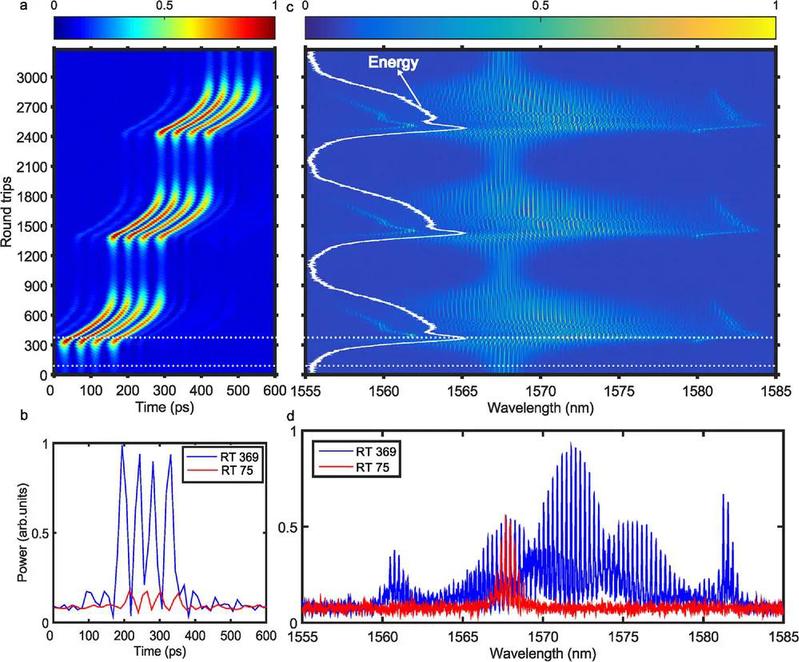
Figure 2 Dynamics of the breather quadruple molecule. a) Temporal evolution of intensity relative to the mean round trip time of consecutive round trips. b) Time intensity distribution of the maximum and minimum energy round-trip times within the oscillation period. c) Dispersive Fourier transform recording of a single excitation spectrum. The evolution of the energy is also shown (solid white line). d) Single excitation spectrum of the number of round trips between the maximum and minimum spectral ranges in one cycle.
A notable phenomenon during the breathing process shown in Figure 2 is that Kelly sidebands appear periodically in the point-to-point spectrum (Figure 2d). These Kelly sidebands are a manifestation of resonant dispersion waves in the time domain. From a general perspective, they are radiated from solitons when they are perturbed by concentrated nonlinear losses and various intracavity components in a round trip. come out. The low-intensity background mode synchronized with the breathing submode observed in Figure 2a is formed by the slowly decaying dispersive wave radiated by the breathing submode, which is the main factor in the long-range interaction of the breathing submode. These dispersive waves are periodically emitted within hundreds of cavity periods, as shown in Figure 2. The central wavelength of the spectrum and the wavelength of the Kelly sideband oscillate synchronously with the pulse energy during the cavity round trip. This wavelength oscillation can be attributed to the cross-phase modulation of respiratory waves and radiative dispersion waves. As can be seen from Figure 2a, this periodic wavelength shift is reflected as a periodic shift in the pulse position in the time domain. In the pseudocolor plot of Figure 2a, pulsations in single-pulse intensity (e.g., round trip number from 300 to 900) are accompanied by a positive (to the right) time shift and no time shift during the duration of the intensity minimum. Therefore, a pulse with a given number of round trips in an oscillation period occurs with a time offset relative to a pulse with the same number of round trips in a previous oscillation period with the same group velocity. It is worth noting that the time-stretched signal lasts longer; for example, the wavelength range in Figure 2c corresponds to a time window of length 25 ns. Therefore, the artificial movement of the pulse temporal position from one oscillation period to the next (100 ps in Figure 2a) has a negligible effect on the dispersion Fourier transform measurement. Calculations of physical time shifts caused by continuous round-trip fiber dispersion are consistent with artificial time shifts observed in space-time intensity maps. Although the Kerr effect can also cause changes in pulse time position, this effect is small and can be ignored.
Under different polarization controller settings, the researchers observed another type of breather complex: a (2+2) breather molecular complex consisting of two bound breather pairs. The spatiotemporal intensity dynamics shown in Figure 3a reveals the existence of two characteristic time scales, corresponding to the pulse interval within each breath pair and the interval between two breath pairs. The ratio between the two characteristic times is approximately 1:7, indicating that the two times appear to be associated with two different intensities. The intramolecular pulse separation is almost the same as that of the breather quadruple molecule in Figure 2, but the intermolecular separation reaches 350 ps, which is an order of magnitude larger than that of the stable soliton molecule complex. By rotation of the polarization controller, different (2+2) breather molecular complexes can be steered (Fig. 3b). Compared to the previous case (Fig. 3a), the pulses of the two respirators combine at different intramolecular time intervals, indicating that breather molecular complexes can have different intramolecular separations.
By tuning the linear cavity loss, the researchers can also reduce the number of breathers and achieve a stable breather ternary complex. An example is provided in Figure 3c showing the spatiotemporal evolution of a breather molecular complex consisting of a respirator pair bound to a single breather, where the latter can be considered as a monatomic molecule. Although a single breather is about 500 ps away from the breather pair, its intensity evolves synchronously with the breather pair during the cavity round trip, indicating the presence of strong intermolecular bonds. Additionally, the researchers observed individual breathing pairs in the laser light.
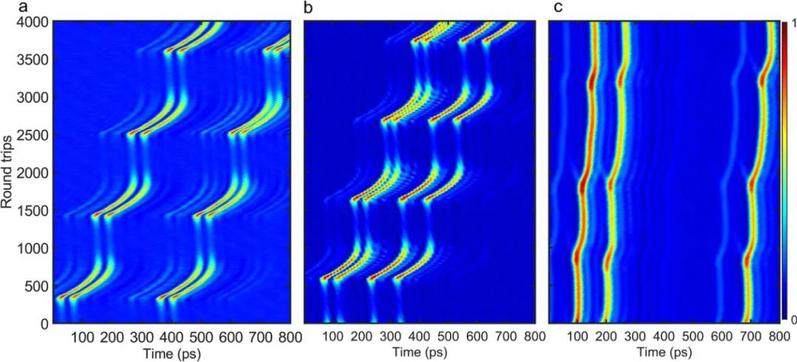
Figure 3 Dynamics of various respirator molecular complexes. a) Time evolution of intensity relative to the mean round-trip time of 4000 consecutive round-trips for a (2+2) breather molecular complex with the same intramolecular pulse interval. b) (2+2) breather molecule complexes with different intramolecular separations and c) (2+1) breather sub-molecule complexes
Soliton interactions are one of the most exciting areas of research in nonlinear dynamics. In traditional systems, such as Bose-Einstein condensates of atoms confined in quasi-dimensional waveguides, soliton collisions can lead to annihilation, depending on the relative phases between the solitons. Soliton annihilation also occurs in dissipative systems. In experiments, the researchers observed breather collisions and destruction within unstable breathing molecule complexes by rotating a polarization controller at a fixed pump power, as shown in Figure 4. In Figure 4a, the initial condition is a breather quartet. Breather fusion occurs at round trip times 2500 and 3500, and then each of the two resulting breathers is split into two pulses at round trip number 5000. Then, one of the two breather pairs gradually disappears.
Figure 4b shows three collision events when the initial condition is the breather ternary complex. In all cases, the scenario is similar to that of elastic collision, since the two colliding breathers simply pass through each other, they are not affected by the collision: they do not merge, and their trajectories do not change after the collision. This is different from the recently observed inelastic breather collisions in passive optical fibers, which represent an example of conventional systems. In this case, in effect, the two breathers merge into one peak. At the same time, by fine-tuning the polarization controller, the researchers can observe different types of non-equilibrium dynamics of breather molecular complexes in the laser. For example, the time interval between the leading wing and the trailing breather in the complex may monotonically increase or decrease during the cavity round trip, and this dynamic state can be referred to as the thermal expansion or contraction of the breather molecular complex.
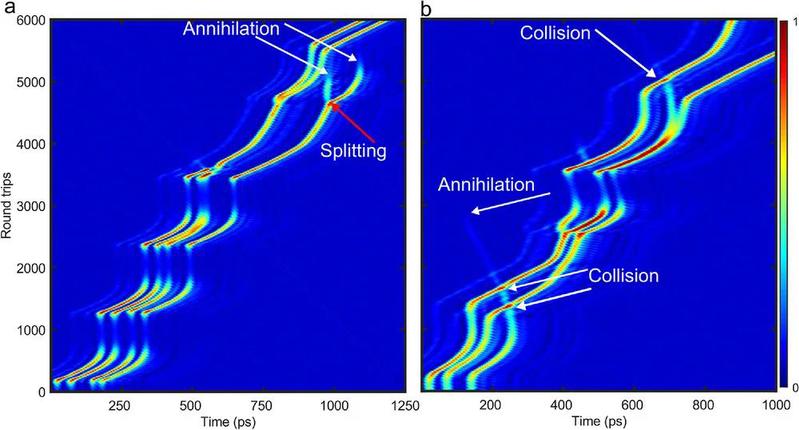
Figure 4 Example of non-equilibrium dynamics of a respirator molecular complex. a) Breather splitting and annihilation of basic breathers with a round trip number of about 5000. b) Three collision events. After the collision, the weak breather eventually disappeared.
Numerical Simulation
Based on the coupled extended nonlinear Schrödinger equation and considering the influence of cross-phase modulation, within the framework of the laser operation vector model, the researchers explained the periodic shift in the center wavelength of the pulsed soliton spectrum and the occurrence of wide Kelly sidebands in the spectrum. Theoretically, the focus is on validating the main characteristic of the observed pulse complexes, namely their periodic behavior. To this end, bypassing a rather complex laser model, the researchers numerically simulated the laser using the master equation method, that is, using the cubic-quintic complex Ginzburg-Landau equation. For passively mode-locked fiber lasers, the cubic-quintic complex Ginzburg-Landau equation takes the form:
iψζ+(D/2)ψττ+|ψ|2ψ+v|ψ|4=iδψ+iε|ψ|2ψ+iβψττ+iμ|ψ|4ψ
where ζ travels through the cavity Normalized propagation distance, τ is the delay time, ψ is the normalized envelope of the field, D=-sgn(β2), β2 is the path average cavity dispersion, and v corresponds to the nonlinear refractive index saturation. The dissipation term is on the right side of the equation,δ>0 (δ<0) is the net linear gain (loss) coefficient, the term with ε represents nonlinear gain (e.g., saturable absorption), and β>0 represents spectral filtering And μ<0 represents the saturation of the nonlinear gain. This equation is one of the simplest models for passively mode-locked lasers with fast saturable absorbers and can describe a variety of complex nonlinear dynamics, such as soliton explosions, optical monsters, multiple pulses, switching dynamics, and dissipative solitons Resonance etc. By numerically solving the complex Ginzburg-Landau equation for the parameter set given in Figure 5, the researchers discovered the periodic breathing dynamics of the bound pulse quartet, qualitatively explaining the behavior observed in Figure 2. In addition, the researchers also discovered different types of respiratory submolecule complexes produced in the experiment through numerical methods (Figure 3), as shown in Figure 6.
In integrable systems, a remarkable property of dissipative solitons is the ability to form stable multi-pulse bound states. Optical cavities constitute an ideal propagation medium for studying multi-soliton interactions, since even very weak interactions can be revealed over an almost infinite propagation time. Soliton pairs constitute the central soliton molecule. Soliton molecules can exist in various isomers. A large number of optical solitons can self-assemble into macromolecules and soliton crystals through their long-range interactions, and even form highly ordered supramolecular structure. Although breathers are fundamentally different from traditional solitons, they exhibit similar collective dynamics. Experimental studies on the generation of breathing pairs in fiber laser cavities have been reported. The focus here is to further push the similarities in collective behavior between breathing solitons and traditional solitons, and the researchers achieved experimental observations and real-time dynamic properties of different types of breather complexes in passively mode-locked fiber lasers, including four-atom molecules and those composed of two A diatomic molecule or a molecular complex formed by the combination of a diatomic molecule and a monatomic molecule. In addition, the researchers observed breather annihilation when the unstable molecular complex was in a phase of declining intensity. Because respiratory dissipative solitons are a fundamental mode in many nonlinear physical systems, the respiratory dynamics observed by the researchers will inspire the study of respiratory submolecular complexes in a variety of other systems.
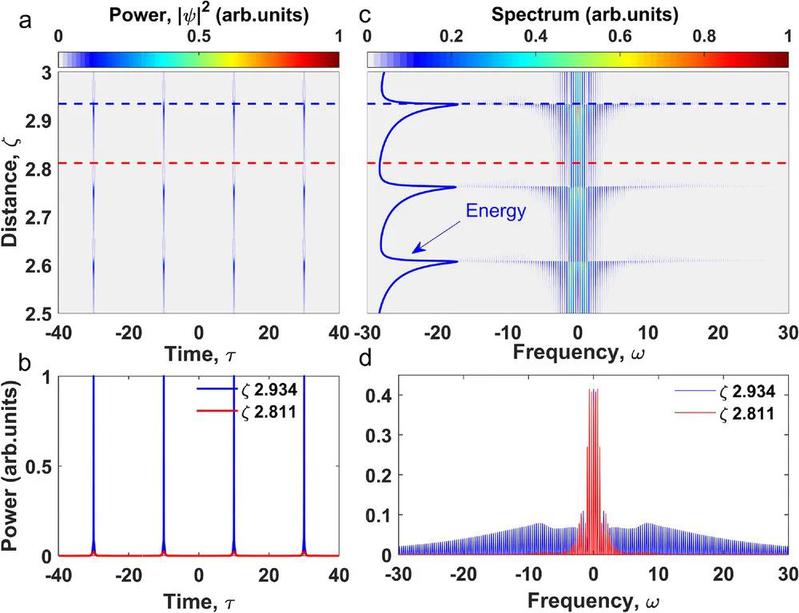
Figure 5 Simulation of the breather quadruple molecule. Evolution of a) temporal intensity and c) spectrum found for a set of complex Ginzburg-Landau equation parameters (v=2, δ=-0.01, β=0.3, ε= 5, μ=-0.02). The evolution of the energy Q (ζ) =∫dτ|ψ(ζ,τ)|2 is also shown. b) Temporal intensity distribution of representative round-trip times of maximum and minimum energy within the oscillation period. d) Corresponding spectra for maximum and minimum ranges.
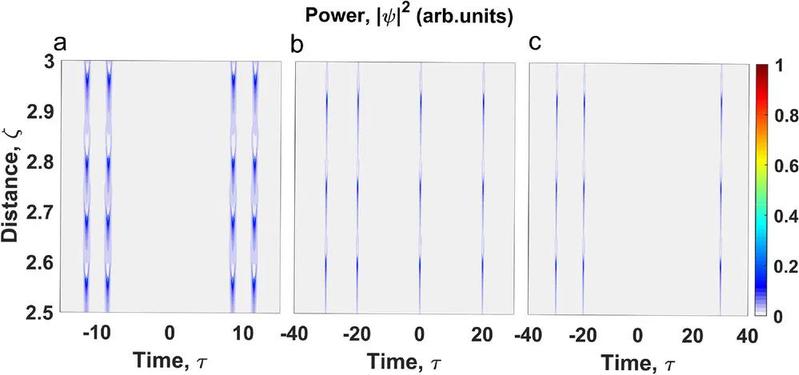
Figure 6 Simulation of various respiratory submolecule complexes. Evolution of the time intensity of the (2+2) respirator molecule complex in iso-intramolecular pulse separation a). b) (2+2) respiratory molecule complexes with different intramolecular separations and c) respiratory molecule complexes. The parameters of the complex Ginzburg-Landau equation are (v=2, δ=−0.23, β =0.4, ε=6, μ=−0.02) and the parameter set shown in Figure 5 is used as shown in Figures (b) and (c) s solution.
Similar to the case of stable solitons, it is possible to assemble supramolecular structures of photobreathers in fiber lasers by exploiting the strong photoacoustic effect in photonic crystal fibers. Since localized wave structures in ultrafast optical fibers are generated in single-mode fibers, studies of them have so far been limited to the time and frequency domains. The generation and transmission of pulses in multimode optical fiber systems have been a hot topic of research in recent years. Multimode fiber lasers provide a new degree of freedom for the control of coherent light fields: the airspace. Therefore, it can be expected that spatiotemporal engineering of light pulses will be able to produce more complex respiratory substructures.
Source:https://mp.weixin.qq.com/s/oKF1ZAP8lvs5GIY8vBw8Xw
Paper link:https://doi.org/10.1002/lpor.202000132
